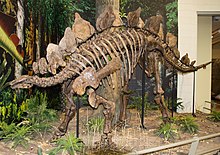Portal:Dinosaurs
IntroductionDinosaurs are a diverse group of reptiles of the clade Dinosauria. They first appeared during the Triassic period, between 243 and 233.23 million years ago (mya), although the exact origin and timing of the evolution of dinosaurs is a subject of active research. They became the dominant terrestrial vertebrates after the Triassic–Jurassic extinction event 201.3 mya and their dominance continued throughout the Jurassic and Cretaceous periods. The fossil record shows that birds are feathered dinosaurs, having evolved from earlier theropods during the Late Jurassic epoch, and are the only dinosaur lineage known to have survived the Cretaceous–Paleogene extinction event approximately 66 mya. Dinosaurs can therefore be divided into avian dinosaurs—birds—and the extinct non-avian dinosaurs, which are all dinosaurs other than birds. Dinosaurs are varied from taxonomic, morphological and ecological standpoints. Birds, at over 11,000 living species, are among the most diverse groups of vertebrates. Using fossil evidence, paleontologists have identified over 900 distinct genera and more than 1,000 different species of non-avian dinosaurs. Dinosaurs are represented on every continent by both extant species (birds) and fossil remains. Through the first half of the 20th century, before birds were recognized as dinosaurs, most of the scientific community believed dinosaurs to have been sluggish and cold-blooded. Most research conducted since the 1970s, however, has indicated that dinosaurs were active animals with elevated metabolisms and numerous adaptations for social interaction. Some were herbivorous, others carnivorous. Evidence suggests that all dinosaurs were egg-laying, and that nest-building was a trait shared by many dinosaurs, both avian and non-avian. (Full article...) Selected articleTriceratops was a herbivorous genus of ceratopsid dinosaur that lived during the late Maastrichtian around 68-65 million years ago in what is now North America; it was one of the last dinosaurs to appear before the great K-T extinction event. Bearing a large bony frill and three horns on its large four-legged body, and conjuring similarities with the modern rhinoceros, Triceratops is one of the most recognizable of all dinosaurs. Though it shared the landscape with, and was preyed upon by, the fearsome Tyrannosaurus, it is unclear whether the two battled the way they are commonly depicted in movies and children's dinosaur books. Although no complete skeleton has been found, Triceratops is well known from numerous partial specimens collected since the genus' introduction in 1887. The function of their frills and three distinctive facial horns has long inspired debate. Although traditionally viewed as defensive weapons against predators, the latest theories suggest these features were primarily used in display for courtship and dominance, much like the antlers and horns of modern reindeer, mountain goats or rhinoceros beetles. (see more...) TopicsSubcategoriesSelected image
Photo credit: User:ДиБгд Did you know...
Things you can do
Peer reviews
Articles to be merged
Articles to be split
Related content
Associated WikimediaThe following Wikimedia Foundation sister projects provide more on this subject:
Discover Wikipedia using portals |





























